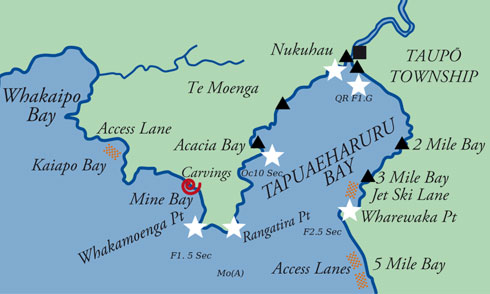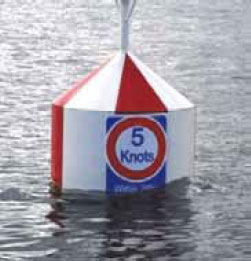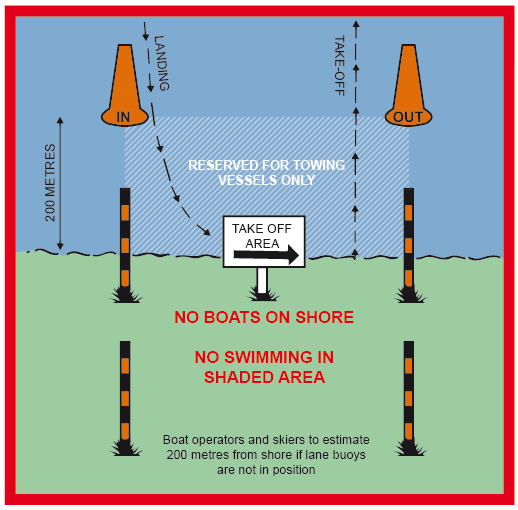Rules for operating vessels
Important information for anyone operating boats or jet skis/personal watercraft (PWC).
- Ten golden rules
- Navigational charts
- Boat speeds and wake
- Lifejackets (PFDs)
- Buoys: 200m from shore
- Minimum age of operators
- Information to display on vessels
- Personal water craft / jet ski
- Ski and tow areas / access lanes
Ten golden rules
- Watch the weather
- Don't overload
- Carry full equipment, warm clothing
- Wear tested lifejackets - a life jacket for every person on board is compulsory
- Ensure your engine is reliable
- Know the Collision Rules, the Water Recreation Regulations, the Lake Taupō Regulations and the Distress Signals
- Guard against fire
- Don't mix drinking and boating
- Carry reserve fuel
- Tell someone where you are going.
Navigational charts
 Navigational charts can be purchased from the Harbourmaster's Office.
Navigational charts can be purchased from the Harbourmaster's Office.
Charts are $25.00 each and two sizes are available.
There is also a chart of Lake Taupō (not to be used as a navigational chart) on the back of the Safe Boating on Taupō Moana brochure.
Boat speeds and wake
The speed limit is five knots within 200 metres of the shore or structures (such as wharves), and five knots within 50 metres of any other vessel, but special restrictions apply at:
- the Waikato River from the red-green entry beacons - three knots maximum
- the Kinloch marina entrance, two knots maximum.
Red-and-white striped buoys have been introduced to show 200 metres from shore.
Speed of small craft
No person shall propel or navigate a small craft at a proper speed exceeding 5 knots:
- within 50 metres of another vessel, raft or person in the water; or
- within 200 metres of the shore or of any structure; or
- within 200 metres of any vessel or raft that is flying flag A of the International Code of Signals (dive flag).
No person may propel or navigate a vessel at a proper speed exceeding 5 knots while any person has any portion of his or her body extending over the forepart, bow or side of that vessel.
Extracts from the Lake Taupō Navigation Safety Bylaw 2017.
Wake of vessels
Every person who propels or navigates a vessel must ensure that its wake does not cause unnecessary danger or risk of damage to other vessels, persons or structures.
Lifejackets (PFDs)
It is mandatory to have a correctly fitting lifejacket (Personal Flotation Device or PFD) for every person on board every boat. Correctly fitting lifejackets (PFDs) MUST BE WORN in all vessels 6m or less in length over all (LOA), whilst ‘making way’.
Buoys: 200m from shore

Red and white striped buoys are placed in a number of locations to show skippers 200 metres from shore.
Note 5 knots within 200 metres of the shore rule applies to all of the Lake Taupō shoreline including rivers unless otherwise stated (access lanes etc).
More useful information about buoys can be found on the Maritime New Zealand website.
Minimum age of operators
No person who is under the age of 15 years shall propel or navigate a motor craft that is capable of a proper speed exceeding 10 knots.
Information to display on vessels
Naming of vessels
Powerboats 4m and over, and non-powered boats 6m and over must display a name or similar identifying mark:
- on both sides of the hull
- above the waterline
It must be clearly legible, and all characters at least 90mm in height. This cannot be the vessel's brand/make/model.
All vessels less than six metres
Emergency contacts on vessels
You must have emergency contact details, including your name and phone number somewhere on or in the vessel which is clearly visible.
Options for providing these details are:
- use a waterproof marker
- write on waterproof tape
- laminate a card and attach it to your vessel
- waterproof paint
- waterproof stick on labels
Personal water craft/jet ski
Personal floatation devices (lifejackets) must be worn when operating jet skis.
The observer rule applies to all watercraft when towing. (You must have an observer who is not under the age of ten years watching the person who is being towed).
Registration
All personal watercraft (PWC)/jet skis used in the waters of the lake must be registered. This is a requirement under the Lake Taupo Navigation Safety Bylaw 2017.
From May 2022, PWC/jetski registration is through Auckland Transport. Waikato Regional Council no longer accepts new registrations or transfers. You can register your PWC/jet ski at https://at.govt.nz/boating-marine/jetskis-personal-watercraft/registering-a-jetski-or-personal-watercraft.
Transferring registration, when buying or selling a jet ski
If you are the seller and your current registration number begins with a 9, your jet ski has been registered with Waikato Regional Council. Waikato Regional Council no longer accepts transfers. Remove the registration stickers and email pwcregistrations@waikatoregion.govt.nz to deregister your jet ski.
If you are the buyer and the registration number begins with a 9, create a new registration with Auckland Transport https://at.govt.nz/boating-marine/jetskis-personal-watercraft/registering-a-jetski-or-personal-watercraft.
If you are the seller and your current registration begins with a 1, log in to your MyAT account to start the process of transferring registration to the buyer https://at.govt.nz/boating-marine/jetskis-personal-watercraft/transferring-jetski-registration.
Ski and tow areas
Access lane markings
Access lanes enable vessels involved in towing to legally leave or approach the shore at speeds in excess of 5 knots.
Direction of travel is anti-clockwise. All access lane buoys are coloured orange and black.
You must:
- Keep to the right in the lanes.
- Enter and leave at right angles to the shore.
- Have an observer who is not under the age of 10 years to report every mishap that occurs to the person and/or object that is being towed.
- Not proceed in a manner dangerous to other persons or vessels in the lane.
- Not beach your boat in the lane.
- Not use lane for any other purposes.
- No person may operate between sunset and sunrise.
- Wear a life jacket when being towed.
Location of access lanes
- Five Mile Bay
- Hallets Bay
- Motutere Bay
- Mission Bay
- Stump Bay
- Waihi Bay
- Kuratau
- Whareroa
- Waihora Bay
- Kawakawa
- Kinloch (Whangamata Bay)
- Kaiapo Bay
